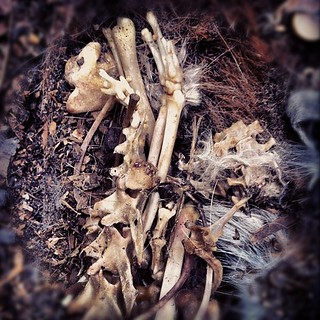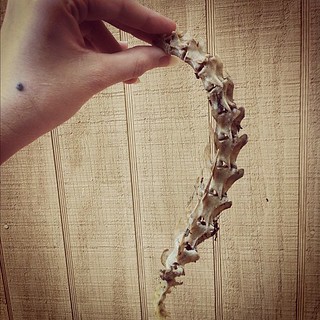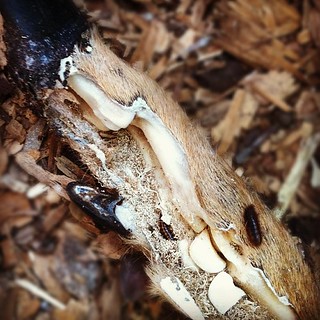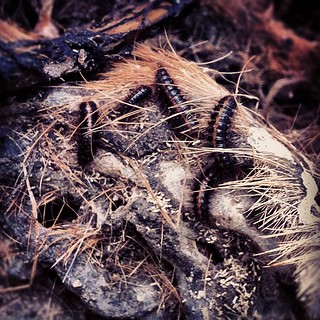
Carrion insects have always been a part of my bone processing but I’ve never had a captive colony of any kind. For a while I had a wild colony of dermestid beetles/larvae helping me clean. As long as I supplied them with new food they stuck around. But I’ve not yet had a captive colony. Ever since that episode of Oddities with the dermestid beetles in a NY apartment I constantly see beginner collectors talking about getting them to clean bones & it makes me cringe.

Sorry but I don't agree that the best way to remove flesh from bones of an animal carcass is by using dermestid beetles. Many that suggests them too frequently neglect to also mention their care, upkeep and not to mention that while dermestid cleaned bones are beautifully flesh free they are also usually absolutely grease saturated. A step that's often completely skipped by me is degreasing because my maceration process often takes care of it. And to be honest I abhor bone degreasing. It is VERY time consuming and tedious. I'm also quite confused how the Oddities episode skips degreasing completely and goes straight from beetle defleshing to the Hydrogen Peroxide bath. As a longtime experienced bone collector/processor I know that scene must be missing or you'll end up with a grease saturated skull in most cases. Wanted to note that I actually do know Ryan and Monique that were in that episode, so I'm by far giving anyone hell... just wanted to point out some important factual things about bone processing and dermestid beetles that I feel were not mentioned in that episode of Oddities.

I still had to macerate this spine after dermestid defleshing because the cartilage was still between the vertebrae.

Care and upkeep of these beetles is far harder than people realize. I can’t recommend against it more if you are a beginner bone collector. Unless you actually need them for smaller animals & have a constant food supply for them, and are REALLY good at pet care I don’t ever suggest them to anyone. Plus, the maceration process is so easy & inexpensive in comparison. You literally need reg tap water, a tight lidded plastic container & patience.

Dermestid beetle care is far more complicated. They need very specific maintained temperatures, humidity, have to keep them free of parasitic mites, have to keep predators from them like spiders, need food/water, proper bedding, lighting, ventilation and enclosure... and so much more. I am currently working on setting up my first captive colony but only after a LOT of online research, talking to friends that successfully have healthy colonies & even located an out-of-print book on the topic. And I’m still not sure if I will be able to keep them alive but I will give it my best shot. The thought of them dying because I can’t properly care for them kills me. So I’ve prepared for this for literally years. Not haphazardly bought a starter colony online at a whim. If I'm successful I will post a followup blog.

There is a great misconception that feeding them alone is enough. Just drop a fleshy skull into your enclosure and you’re done. Or that cleaning bone is super fast and easy with a colony. Far from the truth. It takes a colony of literally 1000s of adults/larvae to even clean a med sized animal head. The larvae actually do most of the work but you need the adults to make more larvae

So this was just a little PSA to REALLY do your research. They need care just like any other kind of pet. Also, if they get loose in your home they can eat a whole lot of other things in every common household besides dried flesh. I've actually lost a lot of my personal collections in the past of smaller bones and insects to wild colonies invading my home. And yes, adults can fly. So you’ve been warned! haha
For more info on the topics discussed here clink on the links in the post to go to my related extensive posts.



10 comments:
Hi! I've read your whole blog, but I still have some questions regarding maceration. I was hoping you could answer them, if it's not too much trouble!
First of all, I should say I'm completely new to this stuff: I'm working on my first skull ever. It's a capybara skull that was naturally cleaned by dermestid beetles. Problem is, half the skull is covered in mummified hide, and it's very hard to remove (and apparently the beetles won't eat it). I'm afraid that if I try any harder, I'll damage the skull, so I started the maceration process anyway. My first question is: is it okay to macerate a skull with that much hide on it, even though it's mummified? I read that you have to remove as much as possible before the process, but I simply couldn't. I'm hoping the process will loosen the hide... Am I right in hoping so? Second question is, should the macerating container be hermetically sealed? Mine is, but I'm wondering if the bacteria will proliferate that way. My last question is, what exactly should I expect after the maceration process? I know the smell will be putrid (and I'm prepared for that), but I want to know if any "creatures" will come out of it. I know this question sounds silly (you can tell I don't know anything about biology haha), but it's just that bugs/maggots/etc sort of bother me, so I wan't to be prepared to deal with whatever comes out of it. I already had a pretty hard time getting rid of the beetles :P
Well, that's it... Thank you in advance, and sorry for this very long comment. I'm really looking forward to an answer! :)
Hi Debora! If you can't easily remove any part of flesh/hide off of the remain by hand try removing as much as you can without scissors being carful not to cut into any bone. I sometimes have to drop a deer head into my maceration tub with half of the face still remaining. It happens, no big deal. I just stress not tossing an entire freshly deceased animal into the maceration tub as I've seen some do. The mummified hide of your capybara should mostly decay away during maceration if not at least completely detach. The fur will likely still be there though. Maceration does no completely dissolve feathers/fur/claws/hooves/etc.
If you visibly see any kind insect larvae in the form of worms/maggots in the maceration water or flies coming out of your maceration tub when you open it then you need a better seal. You don't want these in there because they will eat your bone and possibly even the good bacteria that's removing the flesh from the bone for you. When you open the lid 3 weeks later, you should only see very cloudy putrid reddish brown water with your bones at the bottom. Sometimes there will be fat/mold floating at the top. That's normal.
The bacteria that form in the maceration water is already on the bone/hide you put in the water. It does not come from outside your maceration container.
Good examples of what you'll see are in my blog - The Mathematics Of Maceration - A HowTo Guide For The Impatient - http://bone-lust.blogspot.com/2012/05/mathematics-of-maceration-howto-guide.html
Good luck! jana
Hello! I agree with your post, just wanted to say something that totally blows my collector's mind:
MUSEUMS, even the "best" ones, goes directly from dermestid beetles to peroxyde water.
They EVEN reccomend BOILING bones. What the f***. I've asked Emily from The Brain Scoop (a museum's channel on youtube) about that and she said that they make little holes in some bones to help the grease coming out. I've tried it whit a boiled and grease saturated rabbit femur and it didn't helped even a little bit. Still dealing whit that femur's grease.
Just wanted to share it!
Thank you Jana, that was very helpful! I'm glad I'm doing everything right so far, it would really suck if I ruined this skull. Where I live, it's not so easy to come across dead animals like this. I was so lucky! haha
Yes Naelín I'm aware of this, but thankfully not all museums, college collections & such have outdated practices or some have stopped bleaching/boiling/fully degreasing. I talk about that here some in this blog post. BONELUST Q&A: "How will I know if a skull needs degreasing, I'm not sure what it even looks like?" - http://bone-lust.blogspot.com/2013/06/bonelust-q-how-will-i-know-if-skull.html
Also, watch this video. This one does it right I suspect - http://boingboing.net/2013/11/05/inside-the-whale-warehouse-be.html
Oh, i've seen that video. What's funny is that the person that shared it was exactly the same one that in the past told me to put a hole in the bones. It's good to know that not all museums do it. Thank you!
Where would I dump my maceration water? I live in a family house with neighbors and animals (also in Florida haha) and usually just bury my carcasses in a net for a month or two in ny front side lawn (dogs go in backyard too often) and am going to dig them up and macerate them but I haven't a clue in where to dump the water without my animals or neighbors being bothered
I just dump my maceration water at the base of a tree/bush away from my home. Plants love the nutrients. If you don't want to do that, dig a hole and pour it there then cover to better hide the smell.
HI,
so for my school science fair project I am doing a bone project. I am testing which method for defleshing bones is most effective. I am not sure if the bones that i will find in the wild will have that same amount of flesh on them, so do you think that bones from a butcher would work? thanks for the help.
PS I love your site. It is so cool to know that I share a hobby with so many other people!
That's a good question Stargazer. Having done science projects myself in the past I know that you have to have a consistency. I'm honestly not sure store bought meat will work because of the hormones/chemicals pumped into it. Maybe try freerange chicken or frozen feeder mice/rats from a pt store. Good luck!
Post a Comment